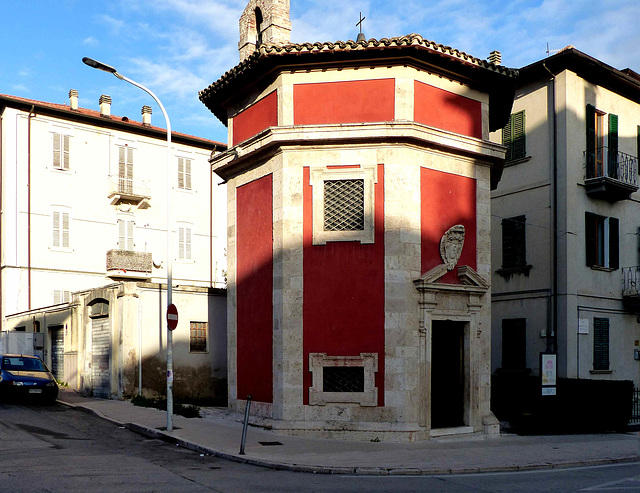Ascoli Piceno - Santa Maria Inter Vineas
Ascoli Piceno - Santa Maria Inter Vineas
Ascoli Piceno - Ponte Romano
Ascoli Piceno - Art Nouveau
Ascoli Piceno - Santi Vincenzo e Anastasio
Ascoli Piceno - Santi Vincenzo e Anastasio
Ascoli Piceno - Cattedrale di Sant'Emidio
Ascoli Piceno - Cattedrale di Sant'Emidio
Ascoli Piceno - Cattedrale di Sant'Emidio
Ascoli Piceno - Cattedrale di Sant'Emidio
Ascoli Piceno - Battistero di San Giovanni
Ascoli Piceno - Piazza del Popolo
Ascoli Piceno - Cafe Meletti
Ascoli Piceno - Cafe Meletti
Morro d'Oro - Santa Maria di Propezzano
Morro d'Oro - Santa Maria di Propezzano
Morro d'Oro - Santa Maria di Propezzano
Morro d'Oro - Santa Maria di Propezzano
Morro d'Oro - Santa Maria di Propezzano
Morro d'Oro - Santa Maria di Propezzano
Morro d'Oro - Santa Maria di Propezzano
Notaresco - San Clemente al Vomano
Notaresco - San Clemente al Vomano
Ascoli Piceno - Lavatoio
Ascoli Piceno
Amandola - Abbazia SS. Rufino e Vitale
Amandola - Abbazia SS. Rufino e Vitale
Sarnano - Santa Maria di Piazza Alta
Sarnano - Santa Maria di Piazza Alta
Sarnano
San Ginesio - Traktor
San Ginesio - Abbazia di Santa Maria delle Macchie
San Ginesio - Abbazia di Santa Maria delle Macchie
Corridonia - San Claudio al Chienti
Corridonia - San Claudio al Chienti
Corridonia - San Claudio al Chienti
Abbazia di Chiaravalle di Fiastra
Abbazia di Chiaravalle di Fiastra
Abbazia di Chiaravalle di Fiastra
Abbazia di Chiaravalle di Fiastra
Abbazia di Chiaravalle di Fiastra
Abbazia di Chiaravalle di Fiastra
Abbazia di Chiaravalle di Fiastra
San Severino Marche - Lancia Beta
San Severino Marche - San Lorenzo in Doliolo
Location
See also...
Keywords
Authorizations, license
-
Visible by: Everyone -
All rights reserved
-
44 visits
Ascoli Piceno - Tempietto di S Emidio Rosso


In 268 BC Ascoli became a Roman "civitas foederata" but after it had revolted against Rome, it was reconquered and destroyed by Pompeius Strabo in 89BC.
During the Middle Ages Ascoli was ravaged by the Ostrogoths and then by the Lombards. After nearly two centuries as part of the Lombard Duchy of Spoleto (593–789), Ascoli was ruled by the Franks but ultimately it was the bishops that gained influence and power over the city.
In 1189 a free republican municipality was established but it experienced the sacking and destruction by the imperial armies of Frederick II. Municipal freedoms got undermined by factional struggles between the most prominent families. The internal unrest between opposing factions did not cease, leading to decades of rebellions, massacres, raids, the growth of banditry and the decline of civil virtues. This unstable situation opened the way to foreign dictatorships, such as condottiero (mercenary) Galeotto Malatesta (14th century) who is driven out by a revolt and later on Francesco Sforza who established a cruel dictatorship (15th century) which was overthrown in 1482, even if Ascoli was forced to recognize the sovereignty of the Church.
The town was called "Ascoli" until 1862, when "Piceno" was added, evoking the Picenes, which lived between the 8th and 6th centuries BC. here.
The small octagonal chapel was built in 1633. According to tradition, the stone slab on which St. Emeidio was decapitated in 309 is conserved under the altar. The walls are red in memory of the Martyr's blood spilled here.
During the Middle Ages Ascoli was ravaged by the Ostrogoths and then by the Lombards. After nearly two centuries as part of the Lombard Duchy of Spoleto (593–789), Ascoli was ruled by the Franks but ultimately it was the bishops that gained influence and power over the city.
In 1189 a free republican municipality was established but it experienced the sacking and destruction by the imperial armies of Frederick II. Municipal freedoms got undermined by factional struggles between the most prominent families. The internal unrest between opposing factions did not cease, leading to decades of rebellions, massacres, raids, the growth of banditry and the decline of civil virtues. This unstable situation opened the way to foreign dictatorships, such as condottiero (mercenary) Galeotto Malatesta (14th century) who is driven out by a revolt and later on Francesco Sforza who established a cruel dictatorship (15th century) which was overthrown in 1482, even if Ascoli was forced to recognize the sovereignty of the Church.
The town was called "Ascoli" until 1862, when "Piceno" was added, evoking the Picenes, which lived between the 8th and 6th centuries BC. here.
The small octagonal chapel was built in 1633. According to tradition, the stone slab on which St. Emeidio was decapitated in 309 is conserved under the altar. The walls are red in memory of the Martyr's blood spilled here.
Marco F. Delminho, Boro, Paolo Tanino have particularly liked this photo
- Keyboard shortcuts:
Jump to top
RSS feed- Latest comments - Subscribe to the comment feeds of this photo
- ipernity © 2007-2024
- Help & Contact
|
Club news
|
About ipernity
|
History |
ipernity Club & Prices |
Guide of good conduct
Donate | Group guidelines | Privacy policy | Terms of use | Statutes | In memoria -
Facebook
Twitter

Sign-in to write a comment.